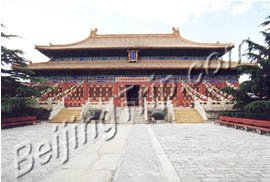

![]()
Hall for Worshipping Ancestors

Figure 4.1: Hall for Worshipping Ancestors
Architecture Information
Click on the image to enlarge it
Detail
Ming Dynasty
The Chinese emperor Jia Jing ordered the construction of the Hall for Worshipping Ancestors in memory of his father on the east side of the Hall of Honoring Compassion instead of constructing an ancestral building (Yu 325). It was constructed in the Inner Court of the Forbidden City. Chinese believed in Confucius, who taught people to have respect and filial piety to their parents and elders (Bary 27). Indeed, Confucius said that filial piety includes worshipping and sacrificing to them when they died (Liu 219). Therefore, worshipping them and putting their names on wooden tablets in the hall became ways to respect them. The Chinese emperor Jia Jing established an ideal way to respect the dead elders and expected others to follow him. Chinese believed that each of their dead ancestor�s spirit lived in his/her individual wooden tablets with his/her names written on them. Therefore, the Hall for Worshipping Ancestors in the Forbidden City was built �near the great Retirement Palace, the Imperial Schoolroom, and the Archery Ground� (Dorn 181). In this way, the dead people�s spirits could see who would join them, and guide as well as look after their young descendants. Therefore, the Chinese emperor Jia Jing spread the Chinese tradition belief of ancestor�s spirit looking after his/her descendants by building the hall. The hall was also used to offer sacrifices to the ancestors. These sacrifices started during the Ming Dynasty (Ru 131). During the Ming Dynasty, only the members of the imperial family and their retainers could enter the Hall for Worshipping Ancestors in the Ming Dynasty (Dorn 184). The Chinese emperor would pay tribute to the ancestors on the imperial birthday, the first day of the New Year, and winter solstice (Yu 177). The Chinese emperor Jia Jing showed his love and respect to his dead father and demonstrated Chinese moral code of the people, which is the Confucian filial piety, in the Forbidden City.
Ching Dynasty
![]()
Home Background Map Religion Libraries Theaters Conclusion Bibliography
Created by May Wong